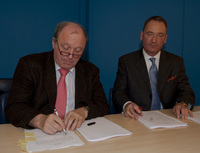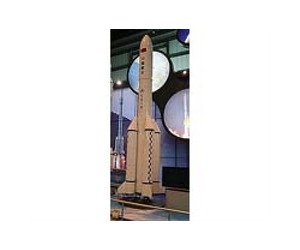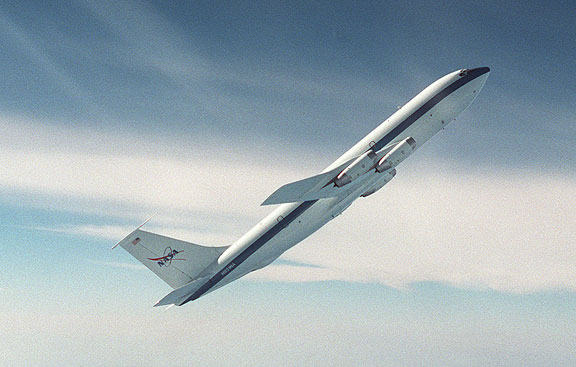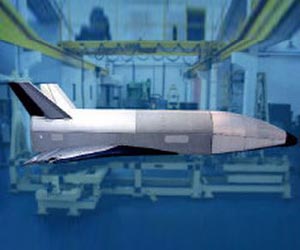Indian rocket tumbles back to Earth during test launch
Article on
http://www.spaceflightnow.com/news/n1004/15gslv/
Indian rocket tumbles back to Earth during test launch
BY STEPHEN CLARK
SPACEFLIGHT NOW
Posted: April 15, 2010
A new hydrogen-fueled third stage tumbled out of control during the launch of India's most powerful rocket Thursday, dooming the $74 million test flight and dealing a blow to the country's burgeoning space program.
The objectives of the sixth flight of the Geosynchronous Satellite Launch Vehicle "were not met fully," said K. Radhakrishnan, chairman of the Indian Space Research Organization.
The primary goal of the launch was to demonstrate a new Indian-built cryogenic third stage consuming super cold liquid hydrogen and liquid oxygen propellants. The cryogenic engine was supposed to ignite about five minutes after liftoff.
File photo of a previous GSLV launch. Credit: ISRO
"The cryo stage ignition was issued as planned by the on-board computer," Radhakrishnan said. "Indications are that the cryo engine ignited. This is to be confirmed after detailed analysis of the data. We saw the vehicle was tumbling, indicating the controllability was lost, most probably [because] the two vernier engines, small cryo engines, would not have ignited and developed the necessary control force."
The two vernier, or steering, engines were supposed to provide small amounts of force to keep the rocket on track during the third stage's 12-minute burn.
But tracking graphics showed the rocket began losing altitude seconds after officials announced third stage ignition. The vehicle reached a maximum altitude of about 87 miles and was traveling approximately 11,000 mph at the time of the mishap, according to displays in the launch control center.
Launch controllers lost tracking data on the uncontrolled rocket a few minutes later as it plunged back into the atmosphere over the Indian Ocean. The final tracking fix on the launcher indicated the vehicle was descending at an altitude of 41 miles about 1,000 miles southeast of the Satish Dhawan Space Center on India's east coast.
"The vehicle was seen tumbling, lost altitude and finally splashed down in the sea," ISRO said in a written statement.
The test flight was a pivotal milestone for India's space program, especially for the country's stated goals of launching its own satellites and developing a manned spacecraft.
The Indian government is on the verge of deciding on a potential human space program aiming to put two astronauts into orbit by 2017. Under such a program, crews would launch into orbit on a rocket using a variant of the Indian-built cryogenic stage.
The GSLV entered service in 2001, but Thursday's mission was the booster's first launch with an Indian-built third stage. Previous missions flew with a Russian cryogenic upper stage purchased by India.
The Russian stage was blamed for two minor glitches in 2001 and 2007 that stranded payloads in slightly different orbits than planned. A liquid-fueled strap-on booster triggered a dramatic explosion shortly after a launch in 2006.
Three other GSLV flights were completely successful.
International missile and defense technology agreements stipulated Russia could only provide ready-made third stages for the GSLV, forcing India to start an in-house program to design and build its own upper stage.
The GSLV's indigenous third stage is prepared for launch. Credit: ISRO
Russia sold seven cryogenic third stages to India in the 1990s. Two units remain in ISRO's inventory for future GSLV flights.
It took nearly two decades to produce India's own cryogenic rocket stage, according to ISRO, the country's space agency.
The first flight of the new cryogenic stage was recently delayed nearly a year as engineers thoroughly tested and analyzed the system's expected performance.
"All of the engineers, scientists, technicians and the entire ISRO team have worked very hard to reach this level," Radhakrishnan said. "It is really the effort of 18 years working on this complex technology. The realization of the cryogenic engine and stage up to a level of flying was, itself, a major accomplishment."
Hydrogen-fueled rockets are more efficient than other propulsion systems.
"Cryogenic stage is technically a very complex system compared to solid or Earth-storable liquid propellant stages due to the use of propellants at extremely low temperatures and the associated thermal and structural problems," said an ISRO fact sheet.
During a public statement announcing the anomaly Thursday, Radhakrishnan said ISRO is targeting a second flight of the indigenous cryogenic upper stage within one year.
But engineers will first investigate the cause of the launch failure.
"The detailed analysis of the flight data will be carried out and we will find out the reasons for the non-ignition of the vernier engines," Radhakrishnan said. "We will also confirm that the main cryogenic engine ignited."
The GSLV performed as expected during the first five minutes of the flight, ISRO officials said.
The 164-foot-tall rocket blasted off from the space base on Sriharikota Island at 1057 GMT (6:57 a.m. EDT). Liftoff occurred at 4:27 p.m. local time at the launch site, which is situated about 50 miles north of the city of Chennai.
After pitching east from the launch pad, the GSLV's four liquid-fueled strap-on boosters and solid-fueled core stage pushed the rocket through partly cloudy skies to the edge of space in less than four minutes.
The GSLV launches Thursday. Credit: ISRO
The GSLV second stage separated about five minutes into the flight, and the cryogenic stage ignited moments later.
Propellant tanks made of aluminum alloy inside the 28-foot-long third stage contained more than 28,000 pounds of liquid hydrogen and liquid oxygen for the flight. The cryogenic engine was designed to burn for nearly 12 minutes, producing a peak thrust of more than 16,000 pounds.
After reaching its target orbit, the upper stage was programmed to deploy the 4,894-pound GSAT 4 experimental communications and navigation satellite, which was also destroyed during Thursday's launch failure.
GSAT 4 carried a high-tech regenerative Ka-band transponder for broadband and multimedia communications trials, a navigation payload to augment Global Positioning System signals for aviation applications, and four plasma thrusters to help keep the spacecraft in the correct position.
The rocket launched Thursday is named the GSLV Mk.2 because it is a second-generation configuration.
Another GSLV upgrade will introduce a brand new liquid-fueled first stage, two massive solid rocket boosters, a restartable second stage and a more efficient third stage. The GSLV Mk.3 upgrades were slated to begin flying in 2012.
India plans to launch the smaller Polar Satellite Launch Vehicle around May 5 with the Cartosat 2B Earth observation satellite and several smaller spacecraft for international organizations.



























